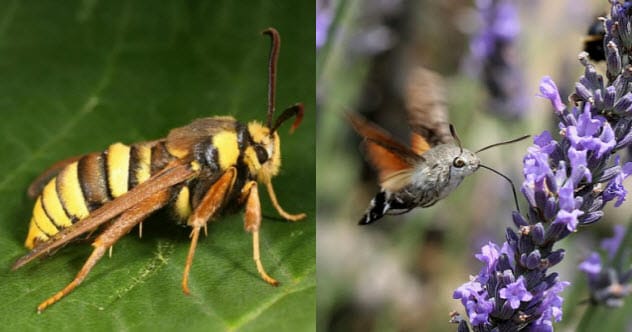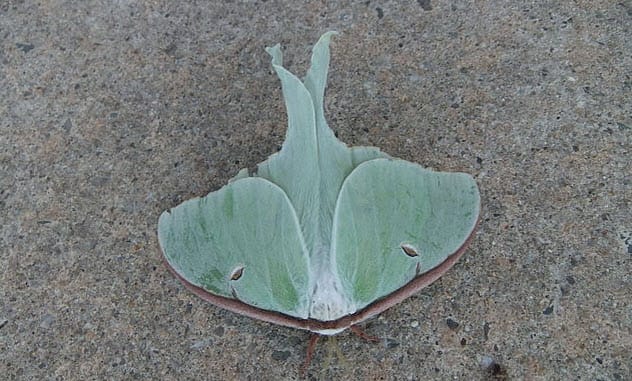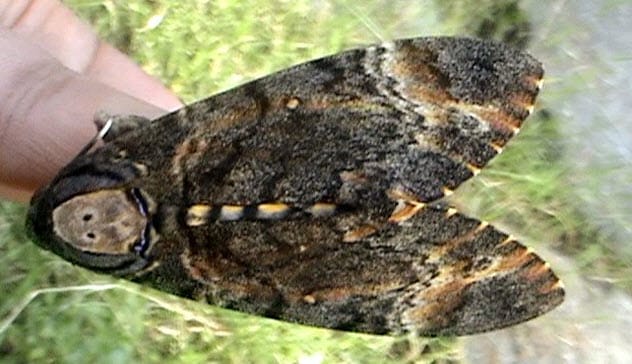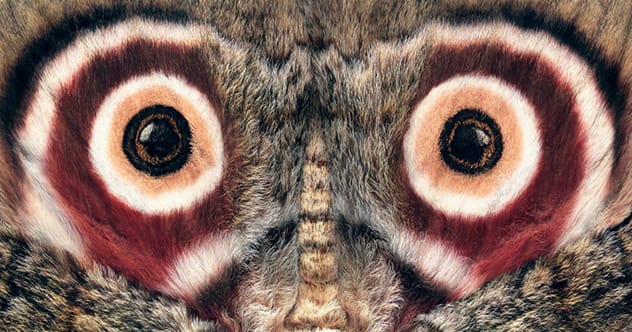You probably think moths are dull, right? Prepare to be amazed! From emitting sonar-scrambling ultrasonic clicks to practicing delicious, pineapple-scented Kama Sutra, the awesomeness of moths goes far beyond anything you’ve ever imagined.
10. One Moth Looks Like a Fuzzy Pokémon Hoax
This fluffy white moth looks so strange that when its pictures first surfaced online in 2009, many dismissed it as a hoax. But, it’s a genuine moth of an unconfirmed species, photographed by zoologist Dr. Arthur Anker in 2009.
Dr. Karl Shuker, a renowned zoologist, writer, and cryptozoologist, verified Anker’s photographs. When Shuker first learned about this bizarre-looking moth in 2012, he made it his mission to confirm the image’s authenticity.
Shuker eventually found Anker and his photos of the poodle moth and other Venezuelan insects on Anker’s Flickr page. As far as Anker knows, he’s the only person to have photographed this fascinating moth, which he named “poodle moth” due to its lack of an official name.
The moth’s species remains debated. Shuker points out that attempts to identify it are strictly opinions until scientists obtain an actual specimen—preferably a living one.
9. Some Moths Look Nothing Like Moths

Typically, we expect moths to be some drab shade of brown. Yet, many moths display brightly colored patterns on their wings, and some resemble entirely different species.
One of the stranger variations is the hornet moth (Sesia apiformis). It uses Batesian mimicry to appear like a hornet, complete with transparent wings uncommon for moths, and jerky movements in flight. This scares away predators wary of stinging insects.
Another fascinating moth is the hummingbird hawkmoth, an example of convergent evolution. It has a long proboscis for sucking nectar from flowers, resembling a hummingbird’s beak. Like a hummingbird, it hovers and moves its wings rapidly, creating an orange blur and a humming sound.
Unlike many nocturnal moths, this one is active during the day.
8. Auditory Deflection and Expendable Body Parts

The luna moth is famous for its beauty and pale green glow. However, it doesn’t create its own light. Instead, scales on its wings reflect moonlight.
Luna moths can’t eat because they lack mouths. Living only about a week, their sole purpose is reproduction, but they must first avoid becoming bat food.
For over 60 million years, bats and moths have been in an evolutionary arms race.
Bats hunt using echolocation, using sonar calls (high-pitched squeaks) to create a visual image from echoes. A moth’s fluttering wings produce a distinct echo, like a dinner bell to a bat. Yet, recent studies show the luna moth’s long tail spins, distorting echoes bouncing back to the bats.
The bat often misses the moth or grabs only a mouthful of tail wing because of this auditory deflection. It’s like the visual deflection of bright eyespots on a butterfly’s wings, directing predators away from vital body parts.
The luna moth’s wing tails are expendable, not affecting their ability to fly and giving them a better chance at sex.
7. Tears For Dinner, Anyone?
Many moths feed on the tears of large animals, while some feed on blood.
In 2004, scientists discovered that Hemiceratoides hieroglyphica, a Madagascan moth, feeds on the tears of sleeping birds. Birds have two eyelids and a protective membrane, harder to pierce than larger animals’ eyelids.
Hemiceratoides hieroglyphica has a unique proboscis, a tiny armory of sharp barbs, spines, and hooks. It uses its harpoon-shaped tip to pierce the bird’s eyelid, anchoring itself while feeding for up to 30 minutes.
Scientists speculate that the moth may spit anesthetic to prevent the bird from waking up and eating it.
6. The Noisy Thief With Chemical Camouflage

The death’s-head hawkmoth, famous from The Silence of the Lambs, has a distinctive skull-like pattern on its thorax. It steals honey directly from beehives, a deadly feat for most insects.
To enter, the death’s-head raises its body and screeches loudly. This has a calming effect on guard bees, making them less likely to attack. A thick cuticle and venom immunity protects it from bees not calmed by the screeching.
Worker bees usually swarm and sting intruders to death, sacrificing their lives. However, the death’s-head avoids this by cloaking itself in a chemical camouflage, mimicking the scent of worker bees. They can’t distinguish it from their own.
The moth continues to squeak, possibly mimicking the queen bee’s command to become passive.
Sometimes mistakes happen, and death’s-heads are found stung to death. But mostly, they are the ultimate, noisy thieves of the night.
5. How Could a Moth Influence Where a Sloth Poops?
Scientists have long wondered why slow, defenseless three-toed sloths descend from their trees weekly to poop on the ground, risking vulnerability to predators.
Over half of all sloth deaths occur during these toilet visits. So, why not poop safely in the trees? What does a moth have to do with it?
A sloth is like a miniature ecosystem with algae, fungi, and mites in its fur. Its hair catches rainwater, keeping the algae moist.
The sloth moth (Cryptoses choloepi) lives only in sloth fur, feeding on skin secretions or algae. It lays its eggs exclusively in sloth poop.
As the sloth defecates, the moths climb out and lay eggs in the dung. The eggs hatch into caterpillars that feed off the poop, develop into moths, and colonize other sloths.
Jonathan Pauli, a wildlife ecology expert, suggests a mutually beneficial arrangement makes sloths risk their lives to cultivate moth eggs.
Pauli’s theory: Algae in the sloth’s fur feed off the moths, consuming nitrogen released by the moths or sloth dung stuck to their bodies.
Sloths rely on algae as a vital nutrient source and for green camouflage to protect against predators.
Some argue that sloths don’t lick their fur and thus don’t benefit nutritionally from the algae. However, Pauli suggests nutrients could be absorbed through the sloth’s skin.
4. Moth Kama Sutra With a Hint of Pineapple

Mating is simple for most moths: the female emits a pheromone scent, and the nearest male mates with her. Gold swift moths are different, having the most elaborate mating rituals in the insect world.
Males gather in a group called a lek, dangling yellow scent brushes emitting a ripe pineapple smell. The sweet pheromone attracts females who choose their mate from the males in the lek.
Sometimes, the female flutters her wings flirtatiously and emits pheromones, choosing a mate from the attracted males.
The moths may dance around each other and copulate midair. This can confuse males, who sometimes try to copulate with each other.
Once mating, the moths choose from flexible positions, usually ending with the male hanging upside down from the female. They can also mate face to face or back to front.
While mating, the moths remain still to avoid being spotted and eaten. This process lasts all night, unless thwarted.
3. Epic Puddler Anal Jets
Moths gather around fluids, dung, and even decaying flesh, called puddling.
Mostly, males partake in this, spending hours guzzling fluids. Gluphisia septentrionis takes it to the extreme, shooting water jets out of its anus.
Moths need sodium, lacking enough in their regular diets. They drink fluids to absorb sodium, then squirt the filtered water out.
Gluphisia septentrionis consumes and shoots around 20 jets per minute, each reaching about 0.3 meters. One moth expelled 4,325 jets in 3.4 hours, 600 times its body mass.
The male passes half his sodium reserves to the female during courtship, who passes it to her offspring, “salting their eggs.”
2. Slow-Motion Brain
Even with the ability to drink nectar from moving flowers while hovering, challenges arise when an insect relies on sight in the dark.
Manduca sexta, a hawkmoth, has the amazing ability to slow down its own brain. This allows better vision in low light while maintaining hovering ability and tracking favorite flowers.
This works like a slower shutter speed, allowing the brain to gather more light.
This reduces reaction time, but, in a perfect adaptation, the moth’s ability to hover only slows to the maximum speed at which its preferred flowers are moving. This maintains feeding and pollination abilities, even in darkness.
1. Ultrasonic Genitals
Moths are a key food source for bats, the most sophisticated acoustic hunters. Tiger moths, however, scramble bat sonar using ultrasound emitters in their thorax.
Upon hearing a bat, the tiger moth times its response, emitting ultrasonic clicks that jam the bat’s sonar, confusing it and giving the moth time to escape.
Three hawkmoth species emit sonar-scrambling signals by rubbing their genitals when they hear a bat, either warning of sharp barbs on their legs or confusing the bat to allow escape.
+ The Hamster With Wings
Rhodinia fugax, the squeaking silk moth, is so fuzzy it resembles a winged hamster. Its caterpillars and pupae squeak, even inside their cocoons.
Touching or disturbing its cocoon elicits a loud squeak. The cocoon, resembling leaves wound around the caterpillars, has a wide opening.
Despite rain entering the opening, the caterpillar includes a drainage hole to prevent flooding.
What’s the craziest moth fact you’ve ever heard? Leave your comment below and share your thoughts!










